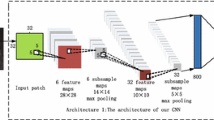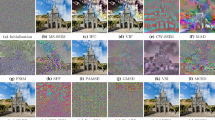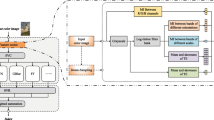Abstract
Reduced-reference paradigms are suitable for supporting real-time modeling of perceived quality, since they make use of salient features both from the target image and its original, undistorted version, without requiring the full original information. In this paper a reduced-reference system is proposed, based on a feature-based description of images which encodes relevant information on the changes in luminance distribution brought about by distortions. Such a numerical description feeds a double-layer hybrid neural system: first, the kind of distortion affecting the image is identified by a classifier relying on Support Vector Machines (SVMs); in a second step, the actual quality level of the distorted image is assessed by a dedicated predictor based on Circular Back Propagation (CBP) neural networks, specifically trained to assess image quality for a given artifact. The general validity of the approach is supported by experimental validations based on subjective quality data.
Preview
Unable to display preview. Download preview PDF.
Similar content being viewed by others
References
ITU: Methodology for the subjective assessment of the quality of television pictures. International Telecommunication Union (1995)
Wang, Z., Sheikh, H., Bovik, A.: The Handbook of Video Databases: Design and Applications. CRC Press, Boca Raton (2003)
Sheikh, H., Sabir, M., Bovik, A.: A statistical evaluation of recent full reference image quality assessment algorithm. IEEE Trans. Image Processing (2006)
Wang, Z., Simoncelli, E.P.: Reduced-reference image quality assessment using a wavelet-domain natural image statistic model. Proc. SPIE Human Vision and Electronic Imaging (2005)
Gastaldo, P., Zunino, Z.: Neural networks for the no-reference assessment of perceived quality. Journal of Electronic Imaging (2005)
Redi, J., Gastaldo, P., Zunino, R., Heynderickx, I.: Co-occurrence matrixes for the quality assessment of coded images. In: Kůrková, V., Neruda, R., Koutník, J. (eds.) ICANN 2008, Part I. LNCS, vol. 5163, pp. 897–906. Springer, Heidelberg (2008)
Huang, J., Kumar, S.R., Mitra, M., Zhu, W., Zabih, R.: Image indexing using color correlograms. In: Proc. IEEE CVPR 1997, pp. 762–768 (1997)
Haralick, R., Shanmugam, K., Dinstein, I.: Textural features for image classification. IEEE Trans. on Systems, Man and Cybernetics SMC-3 (1973)
Sheikh, H., Wang, Z., Cormack, L., Bovik, A.: Image quality assessment database, http://live.ece.utexas.edu/research/quality
Vapnik, V.: Statistical Learning Theory. Wiley, Chichester (1998)
Bartlett, P., Boucheron, S., Lugosi, G.: Model selection and error estimation. Machine Learning, 85–113 (2002)
Ridella, S., Rovetta, S., Zunino, R.: Circular back-propagation networks for classification. IEEE Trans. on Neural Networks, 84–97 (1997)
Rumelhart, D., McClelland, J.: Parallel distributed processing (1986)
Kittler, J., Hatef, M., Duin, R., Matas, J.: On combining classifiers. IEEE Trans. Pattern Analysis and Machine Intelligence (1998)
Kittler, J., Hatef, M., Duin, R., Matas, J.: Final report from the video quality experts group on the validation of objective models of video quality assessment (2000), http://www.vqeg.org/
Author information
Authors and Affiliations
Editor information
Editors and Affiliations
Rights and permissions
Copyright information
© 2009 Springer-Verlag Berlin Heidelberg
About this paper
Cite this paper
Redi, J., Gastaldo, P., Zunino, R. (2009). Hybrid Neural Systems for Reduced-Reference Image Quality Assessment. In: Alippi, C., Polycarpou, M., Panayiotou, C., Ellinas, G. (eds) Artificial Neural Networks – ICANN 2009. ICANN 2009. Lecture Notes in Computer Science, vol 5769. Springer, Berlin, Heidelberg. https://doi.org/10.1007/978-3-642-04277-5_69
Download citation
DOI: https://doi.org/10.1007/978-3-642-04277-5_69
Publisher Name: Springer, Berlin, Heidelberg
Print ISBN: 978-3-642-04276-8
Online ISBN: 978-3-642-04277-5
eBook Packages: Computer ScienceComputer Science (R0)




